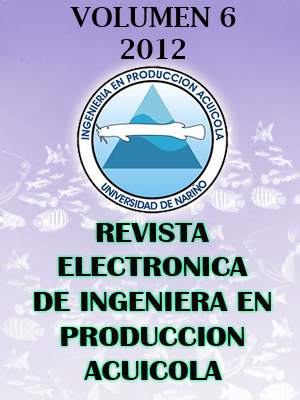EVALUACIÓN Y CRECIMIENTO DE LA ESPECIE ÍCTICA SABALETA (Brycon sp.) NATIVA DE LAS CUENCAS DEL RÍO MAYO Y JUANAMBÚ.
Resumen
Esta investigación evaluó la adaptación y crecimiento de la especie ictica nativa Sabaleta (Brycon sp), perteneciente a las cuencas del río Mayo y Juanambú, en el departamento de Nariño-Colombia. Este estudio se realizó en la estación Piscícola la Paraiso municipio de Chachagüi – Nariño; durante 76 días, tiempo en el cual se midió y analizaron resultados de crecimiento, talla, peso, sobrevivencia, conversión alimenticia y la adaptación de la especie al cautiverio.
Los resultados obtenidos, demostraron que la especie se adaptó al cautiverio de manera adecuada, al alimento balanceado, a la manipulación y a las condiciones ambientales del estanque, logrando inclusive mostrar señales de maduración en hembras tales como presencia de ooctitos en sus primeros estadios de maduración y en macho principalmente expulsión de semen.
Los alevinos estudiados demostraron su capacidad de adaptación al cautiverio y a las nuevas condiciones ambientales, logrando incrementar su peso de 4,42±0,79 g hasta 15,42±4,19 g, así mismo su talla de 3,75±0,624 cm hasta 10,99±0,97 cm, con respecto a la sobrevivencia se obtuvo un 100% indicando que las condiciones fueron adecuadas, además la tasa de crecimiento simple fue de 28,62%, con un máximo del 39, 62% en los primeros quince días de estudio y un 18,59% en el último periodo
La biomasa inicial fue de 1.104,17g con una carga de 46 g/m3, al finalizar la biomasa total fue de 3.854,17g, con un incremento de 2.750 g y una carga de 160,59 g/m3 con un incremento total del 350% y respecto a la conversión alimenticia se obtuvo 5,11:1, lo cual indica que esta especie aceptó el balanceado pero requiere un alimento acorde a sus exigencias nutricionales y mejorar así estos resultados.
Palabras Claves: Alevino, adaptación, Sabaleta (Brycon sp), especie nativa, cautiverio.
SUMMARY
This study evaluated the adaptation and growth of native fish species Sabaleta (Brycon sp), part of Mayo River watershed and Juanambu in the department of Nariño, Colombia. This study was conducted in the Paradise Fish Station Chachagüí Township - Nariño for 76 days, at which time was measured and analyzed results of growth, height, weight, survival, feed conversion and adaptation of the species in captivity.
The results showed that the species was adapted to captivity properly, to feed, to handling and environmental conditions of the pond, making even show signs of maturation in females such as the presence of ooctitos in the early stages of maturation and mainly in male semen discharged.
The fry studied demonstrated their ability to adapt to captivity and the new environmental conditions, thereby increasing its weight of 4.42 ± 0.79 g to 15.42 ± 4.19 g, likewise a size of 3.75 ± 0.624 cm to 10.99 ± 0.97 cm, with respect to survival was obtained a 100% indicating that the conditions were suitable, besides simple growth rate was 28.62% with a maximum of 39, 62% in the first fifteen days of study and 18.59% in the fourth quarter
Initial biomass was 1104.17 g under a load of 46 g/m3, the end of the total biomass was 3854.17 g, an increase of 2,750 g and a load of 160.59 g/m3 with a total increase of 350% and feed conversion compared to 5,11:1 was obtained, indicating that this species accepted but requires a balanced food according to their nutritional requirements and improve these results.
Key words: alevine, adaptation, Sabaleta (Brycon sp), native species, captive.

